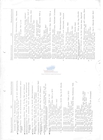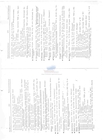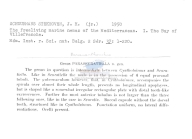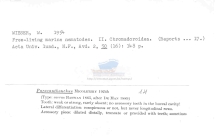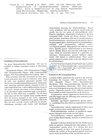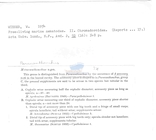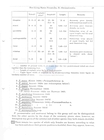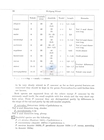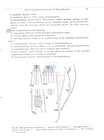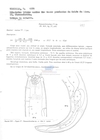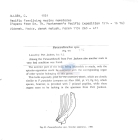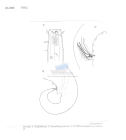
|
World Database of NematodesLinked to the Marine Biology Section, UGent |
| Start | Browse taxonomy |
Search taxonomy |
Search literature |
Search distributions |
Identification keys |
Media gallery | Editors | Statistics | Citations | Match taxa | Contact | Login |
NARMS taxon detailsParacanthonchus Micoletzky, 1924
2320 (urn:lsid:marinespecies.org:taxname:2320)
accepted
Genus
marine, brackish,
Micoletzky, H. (1924). Letzter Bericht �ber freilebende Nematoden aus Suez. Sber. Akad. Wiss. Wien Mathem.-naturw. Klasse. Abteilung I, Band 133, Heft 4/6: 137-179., available online at http://www.landesmuseum.at/pdf_frei_remote/SBAWW_133_0137-0179.pdf
page(s): 138 [details]
Nemys eds. (2024). Nemys: World Database of Nematodes. Paracanthonchus Micoletzky, 1924. Accessed through: Costello, M.J.; Bouchet, P.; Boxshall, G.; Arvanitidis, C.; Appeltans, W. (2024) European Register of Marine Species at: https://marbef.org/data/aphia.php?p=taxdetails&id=2320 on 2025-04-06
Costello, M.J.; Bouchet, P.; Boxshall, G.; Arvanitidis, C.; Appeltans, W. (2025). European Register of Marine Species. Paracanthonchus Micoletzky, 1924. Accessed at: https://www.vliz.be/vmdcdata/narms/narms.php?p=taxdetails&id=2320 on 2025-04-06
Date action by 2004-12-21 15:54:05Z created db_admin 2006-09-26 06:56:50Z changed Martinez, Olga
original description
Micoletzky, H. (1924). Letzter Bericht �ber freilebende Nematoden aus Suez. Sber. Akad. Wiss. Wien Mathem.-naturw. Klasse. Abteilung I, Band 133, Heft 4/6: 137-179., available online at http://www.landesmuseum.at/pdf_frei_remote/SBAWW_133_0137-0179.pdf
page(s): 138 [details] basis of record Nemaslan: Biodiversity of Antarctic Nematodes (2004). (look up in IMIS) [details] additional source Brunel, P., L. Bosse & G. Lamarche. (1998). Catalogue of the marine invertebrates of the estuary and Gulf of St. Lawrence. Canadian Special Publication of Fisheries and Aquatic Sciences, 126. 405 pp. (look up in IMIS) [details] Available for editors additional source Integrated Taxonomic Information System (ITIS). , available online at http://www.itis.gov [details] additional source Gerlach, S. A. (1965). Freilebende Meeresnematoden aus der Gezeitenzone von Spitzbergen. Ver�ffentlichungen des Instituts f�r Meeresforschung in Bremerhaven. 9: 109-172. [details] Available for editors additional source Shirayama, Y. (1992). Studies of meiofauna collected from the Iheya Ridge during the dive 541 of the "SHINKAI 2000". Proc. JAMSTEC symp. deep Sea Research. 8, 287-291. [details] Available for editors additional source Soetaert, K.. M. Vinckx, J. Wittoeck & M.Tulkens. (1995). Meiobenthic distribution and nematode community structure in five European estuaries. Hydrobiologia. 311: 185-206. (look up in IMIS) [details] Available for editors additional source Steyaert, M.; Moodley, L.; Vanaverbeke, J.; Vandewiele, S.; Vincx, M. (2005). Laboratory experiments on the infaunal activity of intertidal nematodes. Hydrobiologia. 540(1-3): 217-223. (look up in IMIS), available online at https://doi.org/10.1007/s10750-004-7145-4 [details] Available for editors additional source Van Gaever, S.; Gal�ron, J.; Sibuet, M.; Vanreusel, A. (2009). Deep-sea habitat heterogeneity influence on meiofaunal communities in the Gulf of Guinea. Deep Sea Research Part II: Topical Studies in Oceanography. 56(23): 2259-2269., available online at https://doi.org/10.1016/j.dsr2.2009.04.008 [details] Available for editors additional source Van Gaever, S.; Vanreusel, A.; Hughes, J.; Bett, B.; Kiriakoulakis, K. (1999). The macro- and micro-scale patchiness of meiobenthos associated with the Darwin Mounds (north-east Atlantic). Journal of the Marine Biological Association of the UK. 84(3): 547-556., available online at https://doi.org/10.1017/s0025315404009555h [details] Available for editors additional source Vanreusel, A.; Van Den Bossche, I.; Thiermann, F. (1997). Free-living marine nematodes from hydrothermal sediments: similarities with communities from diverse reduced habitats. Mar. Ecol. Prog. Ser. 157: 207-219. [details] Available for editors additional source Venekey, V.; Fonseca-Genevois, V.; Santos, P. J. P. (2010). Biodiversity of free-living marine nematodes on the coast of Brazil: a review. Zootaxa. 2568: 39�66. [details] Available for editors additional source Vitiello, P. (1970). N�matodes libres marins des vases profondes du Golfe du Lion. II. Chromadorida. T�thys. 2: 449-500. [details] Available for editors additional source Warwick, R. M.; Buchanan, J. B. (1970). The meiofauna off the coast of Northumberland. I. The structure of the nematode population. J. mar. biol. Ass. U. K. 50: 129-146. [details] Available for editors additional source Zekely, J.; Gollner, S.; Van Dover, C. L.; Govenar, B.; Le Bris, N.; Nemeschkal, H. L.; Bright, M. (2006). Nematode communities associated with tubeworm and mussel aggregations on the East Pacific Rise. Cah. Biol. Mar. 47: 477-482. [details] Available for editors additional source Zekely, J.; Van Dover, C.; Nemeschkal, H.; Bright, M. (2006). Hydrothermal vent meiobenthos associated with mytilid mussel aggregations from the Mid-Atlantic Ridge and the East Pacific Rise. Deep Sea Research Part I: Oceanographic Research Papers. 53(8): 1363-1378., available online at https://doi.org/10.1016/j.dsr.2006.05.010 [details] Available for editors additional source Neave, Sheffield Airey. (1939-1996). Nomenclator Zoologicus vol. 1-10 Online. [Online Nomenclator Zoologicus at Checklistbank. Ubio link has gone]. , available online at https://www.checklistbank.org/dataset/126539/about [details] additional source Various Authors (2000). Nematode filing cabinet of the Marine Biology Section Ugent - in combination with the NemasLan Ms-Access database (published on CD-Rom, 2000) (look up in IMIS) [details] additional source Muller, Y. (2004). Faune et flore du littoral du Nord, du Pas-de-Calais et de la Belgique: inventaire. [Coastal fauna and flora of the Nord, Pas-de-Calais and Belgium: inventory]. Commission R�gionale de Biologie R�gion Nord Pas-de-Calais: France. 307 pp., available online at http://www.vliz.be/imisdocs/publications/145561.pdf [details] additional source Zeppilli, D. & R. Danovaro (2009). Meiofaunal diversity and assemblage structure in a shallow-water hydrothermal vent in the Pacific Ocean. Aquatic Biology. 5(1):75-84., available online at https://doi.org/10.3354/ab00140 [details] Available for editors additional source Verschelde, D.; Nicholas, W.; Vincx, M. (2006). A Review of the Genera Croconema Cobb, 1920 and Pseudochromadora Daday, 1899 (Nematoda, Desmodoroidea): New Species from the Coasts of Kenya and Australia. Hydrobiologia. 571, 17-40. (look up in IMIS) [details] additional source Copley, J. T. P.; Flint, H. C.; Ferrero, T. J.; Van Dover, C. L. (2007). Diversity of meiofauna and free-living nematodes in hydrothermal vant mussel beds on the northern and southern East Pacific Rise. J. Mar. Biol. Ass. U.K. [details] Available for editors additional source Pastor de Ward, C. T. (2001). A new nematode from West Patagonian coasts Biarmifer madrynensis sp. N., with a redefinition of genus Biamifer Wieser 1954 (Nematoda, Cyatholaimidae). Biologie. 71: 139-149. [details] Available for editors additional source Da Rocha, C. M. C.; Venekey, V.; Bezerra, T. N. C.; Souza, R. B. (2006). Phytal marine nematode assemblages and their relation with the macrophytes structural complexity in a Brazilian tropical rocky beach. Hydrobiologia. 553:219-230. [details] Available for editors additional source Decraemer, W.; Coomans, A. (1978). Scientific Report on the Belgian Expedition to The Great Barrier Reef in 1967. Nematodes XII. Ecological Notes on the Nematode Fauna in and around Mangroves on Lizard Island. Aust. J. Mar. Freshwater Res. 29, 497-508. (look up in IMIS), available online at https://doi.org/10.1071/MF9780497 [details] Available for editors additional source Derycke, S.; Van Vynckt, R.; Vanaverbeke, J.; Vincx, M.; Moens, T. (2007). Colonization patterns of Nematoda on decomposing algae in the estuarine environment: community assembly and genetic structure of the dominant species Pellioditis marina. Limnology and Oceanography. 52(3): 992-1001. (look up in IMIS) [details] Available for editors additional source Guo, Y.; Hell�ouet, M.-N.; Boucher, G. (2008). Spatial patterns of meiofauna and diversity of nematode species assemblages in the Uvea lagoon (Loyalty Islands, South Pacific). Journal of the Marine Biological Association of the United Kingdom. 88(5), 931�940. [details] Available for editors additional source Gobin, J. F. (2007). Free-living marine nematodes of hard bottom substrates in Trinidad and Tobago, West Indies. Bulletin of Marine Science. 81(1): 73�84. [details] additional source Maria, T. F.; Esteves, A. M.; Smol, N.; Vanreusel, A.; Decraemer, W. (2008). Nematodes from sandy beaches of Guanabara Bay, Rio de Janeiro, Brazil. Bioci�ncias, Porto Alegre. 16 (2), 92-103. [details] Available for editors additional source Miljutin, D. M.; Gad, G.; Miljutina, M. M.; Mokievsky, V. O.; Fonseca-Genevois, V.; Esteves, A. M. (2010). The state of knowledge on deep-sea nematode taxonomy: how many valid species are known down there?. Marine Biodiversity. 40(3): 143-159., available online at https://doi.org/10.1007/s12526-010-0041-4 [details] Available for editors ecology source Raes, M.; De Troch, M.; Ndaro, S. G. M.; Muthumbi, A.; Guilini, K.; Vanreusel, A. (2007). The structuring role of microhabitat type in coral degradation zones: a case study with marine nematodes from Kenya and Zanzibar. Coral Reefs. 26 (1): 13-126. [details] Available for editors ecology source Raes, M.; Vanreusel, A. (2006). Microhabitat type determines the composition of nematode communities associated with sediment-clogged cold-water coral framework in the Porcupine Seabight (NE Atlantic). Deep-Sea Research Part I. 53 (12): 880-1894. [details] Available for editors ecology source Derycke, S.; Vanaverbeke, J.; Rigaux, A.; Backeljau, T.; Moens, T. (2010). Exploring the Use of Cytochrome Oxidase c Subunit 1 (COI) for DNA Barcoding of Free-Living Marine Nematodes. PLoS ONE. 5(10): e13716., available online at https://doi.org/10.1371/journal.pone.0013716 [details] Available for editors identification resource Miljutina, M. A.; Miljutin, D. M. (2015). A revision of the genus Paracanthonchus (Cyatholaimidae, Nematoda) with a tabular key to species and a description of P. mamubiae sp. n. from the deep North-Western Pacific. Deep Sea Research Part II: Topical Studies in Oceanography. 111: 104-118., available online at https://doi.org/10.1016/j.dsr2.2014.08.002 note: Review of genus and table key to species (except P.sandspitensis) [details] Available for editors  Present Present  Inaccurate Inaccurate  Introduced: alien Introduced: alien  Containing type locality Containing type locality
|
Web interface and database structure initially created by Tim Deprez; now hosted and maintained by VLIZ
Page generated 2025-04-07 · contact: Tânia Nara Bezerra or info@marinespecies.org


